|
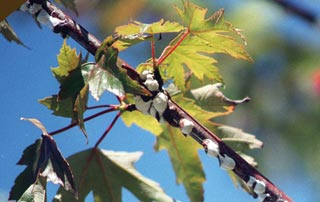
Cottony maple scale may be found on currants, gooseberry, grapes, as well as maples. 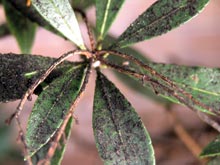
Azalea bark scale shown on an azalea also may be found on rhododendrons. 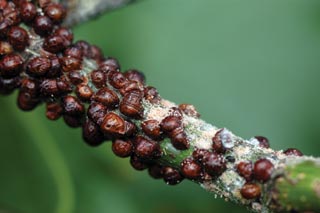
Lecanium scale found on woody plants such as azaleas and rhododendrons. ScaleDownload a PDF of this articlePlants AffectedAll types of fruit and ornamental trees, shrubs. Symptoms/DamageScales are so unusual looking that most people donít recognize them as insects. Most adult scales do not move, they look like brown or white “tortoise shells” on branches or foliage. Some are covered with a white waxy substance. Scales have piercing mouthparts that suck juices out of the plant. Severe infestations of scale can cause overall decline or even death of the plant. Most scales excrete sticky honey dew that can drip down onto cars and buildings and make a gummy mess. Often this honeydew is attacked by a black sooty mold. Life CycleSome scales have only one generation per year and others can have multiple generations. Typically, scales over winter as an adult scale. Then in late spring eggs are produced hidden under the mother scale. The eggs hatch in late spring and early summer into tiny microscopic crawlers. These crawlers walk over plant surfaces, get blown by wind to new trees or moved by birds. ManagementCulturalScales are often kept in check by natural enemies like parasitic wasps. However scale populations can sometimes get out of control and cause plant damage or be a nuisance with sticky honeydew. OrganicWell timed sprays of oil during the dormant season and when crawlers are active should provide good control. |
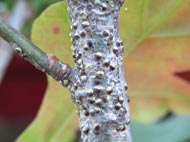
Oak Pit Scale. 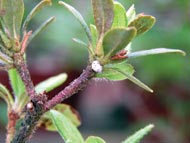
Azalea bark scale shown on an azalea also may be found on rhododendrons. |
|
Home |
Services |
The Arbor Advisor |
Garden Calendar |
About Us |
Fact Sheets |
Contact Us |
Site Map Collier Arbor Care Portland 503-722-7267 Vancouver (360) 693-6056 Site contents and design ©2013 Collier Arbor Care |





